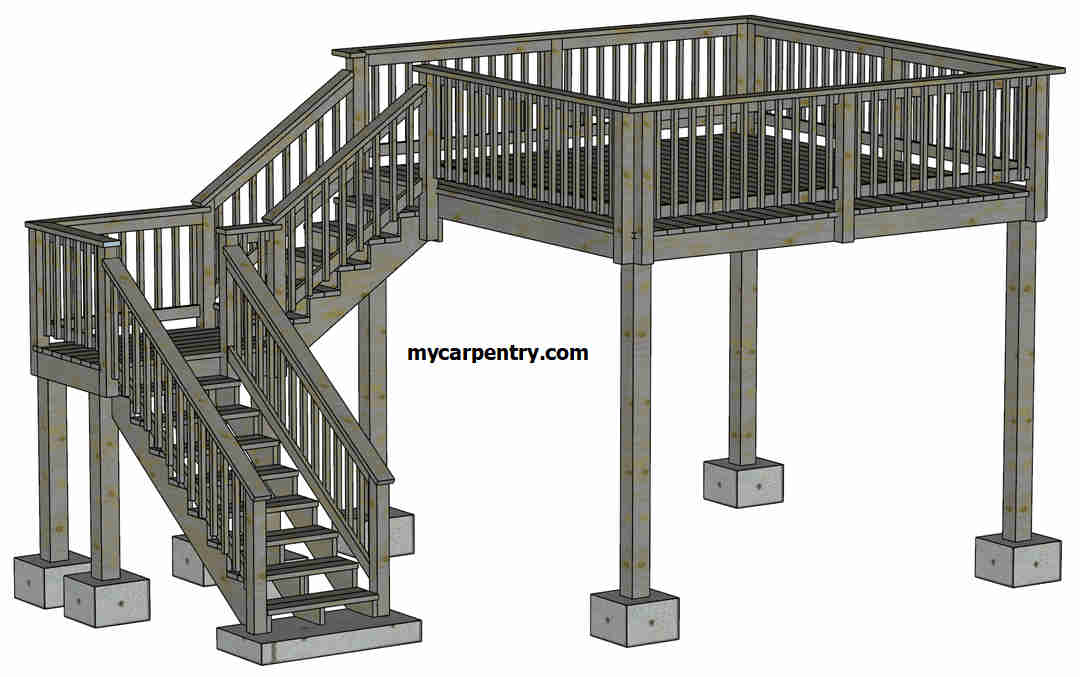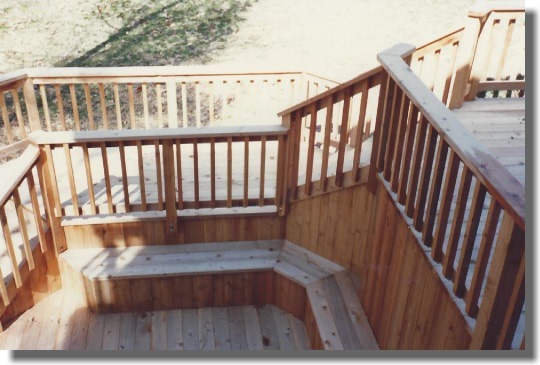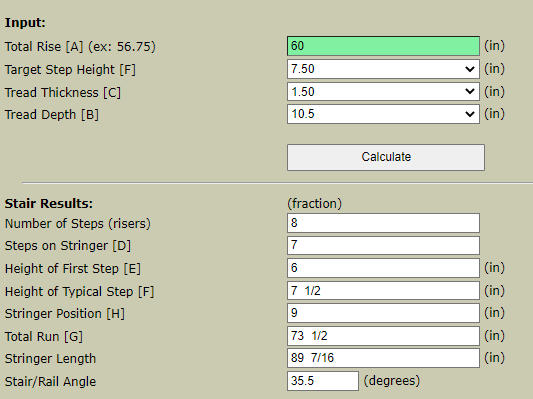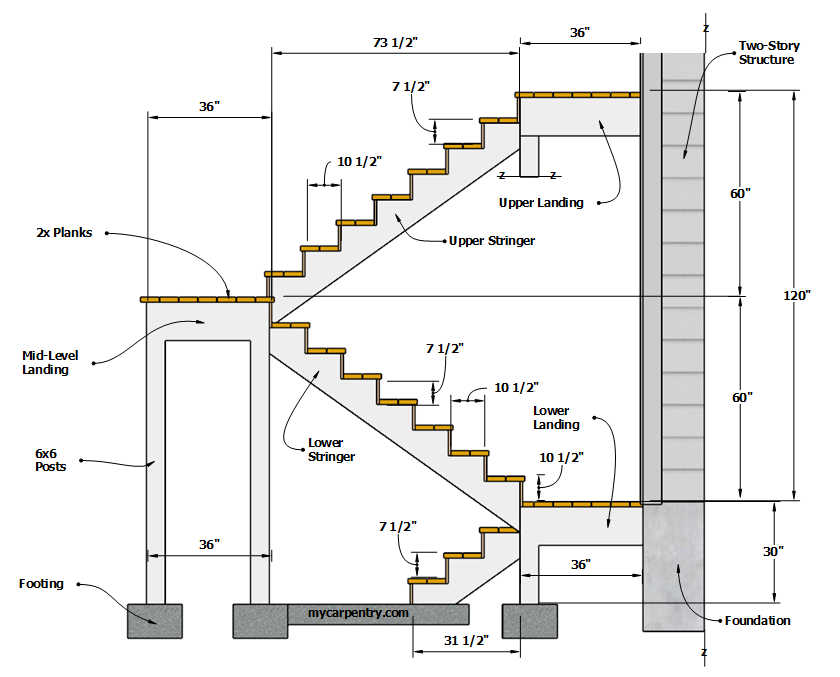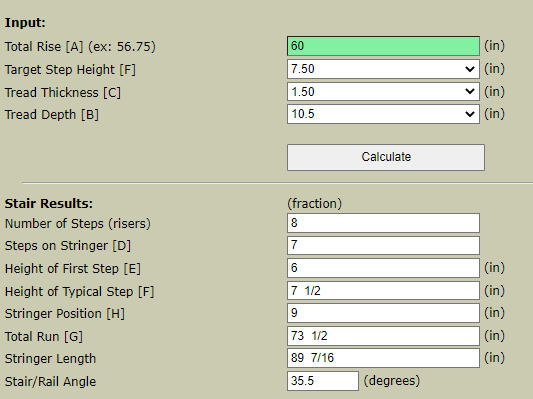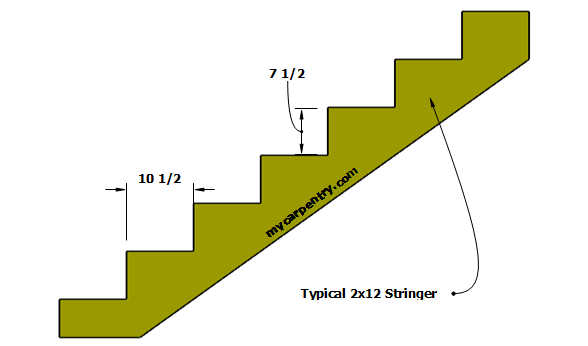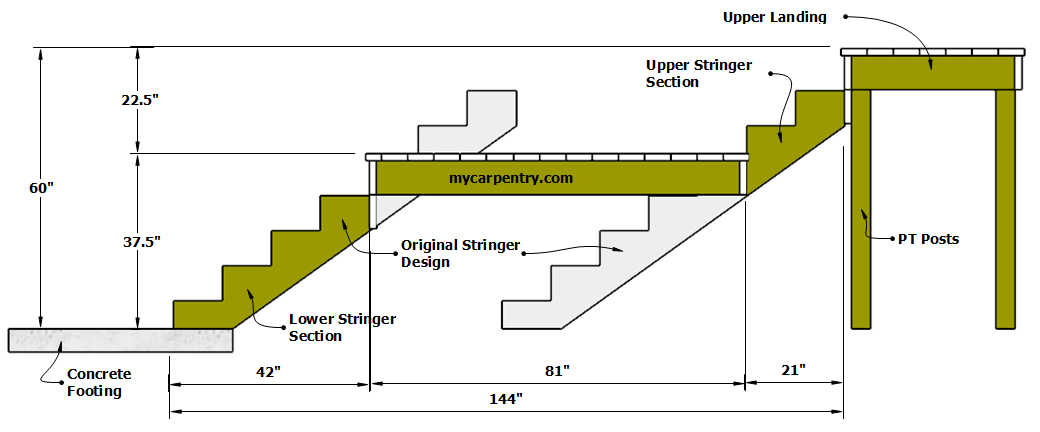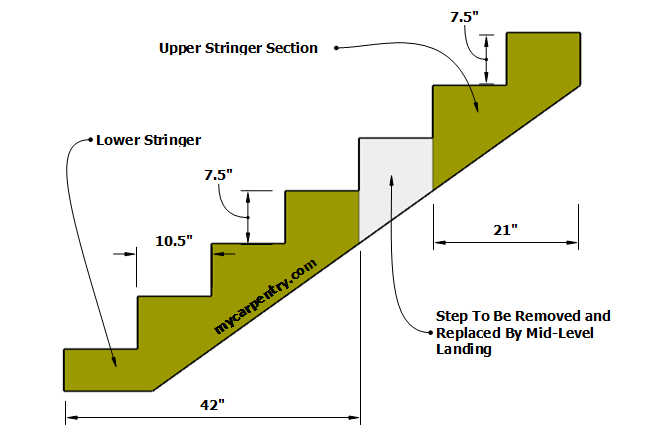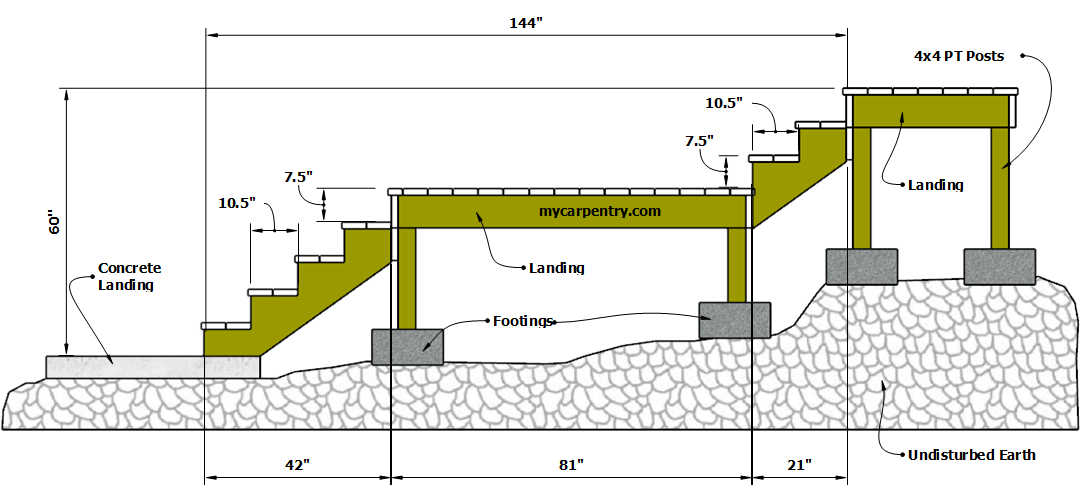Stairs with landings
Building stairs with landings is a common practice when designing and building stairs. Stair landings can separate long runs of stairs and be used to redirect runs of stairs (shown below).
International Building Code states that a flight of stairs shall not have a vertical rise greater than 151 inches (3835 mm) between floors or landings. So what do I do if my Total Rise exceeds 151 inches?
Calculating Stairs with Landings
If the Total Height of your stairs exceeds the building code limitation, a landing may be required. Or, you may want to break up a run of stairs with a landing as a place to rest or enjoy the view of a room or outdoor scene before continuing.
There are also situations where the slope of the terrain changes irregularly, and a series of level walkways (landings) between runs of stairs is required so that each Step Rise stays the same.
In the following sections, I will explain both scenarios in more detail. Please note that this page assumes you know how to layout and cut stair stringers. If you need a refresher, read the building stairs tutorial.
Scenario 1 - Mid-Level Landing Between Floors
In this scenario, our design requires access from a first-floor landing to a second-floor landing. The design specifications require a mid-level landing between two runs of stairs. The height of the second floor is 120 inches above the first floor. When I build stairs with a mid-level landing, I always set the Landing Height half of the Total Height. In this case, 60 inches. You can use the Automatic Stair Calculator to calculate the rise and run of the upper and lower stringers. Enter 60 inches into the Total Rise [A] field. Change the Target Step Height [F] to 7.50 inches. Click the Calculate button.
The calculated results, shown below, are a screen capture from the Automatic Stair Calculator.
The Typical Step Height [F] is 7 1/2 inches. The Tread Depth [B] of each step is 10 1/2 inches. When the Landing Height is half the height of the Total Height, the upper and lower stair stringers are identical.
The horizontal distance of the mid-level landing is the Steps on Stringers multiplied by the Tread Depth [B] of each step. In this case, it is seven steps multiplied by 10.5, or 73 1/2 inches.
The height of the landing does not have to be half the Total Rise [A]. You can build a landing along any one of the calculated Step Heights. For example, if you use the Automatic Stair Calculator (with [F] set to 7.5) to calculate the Number of Steps and the Typical Step Height [F] on a Total Rise of 120 inches, the Typical Step Height would be 7 1/2 inches and the number of Steps on Stringer would be 15 (16 rises). Think of a landing as just another step (see diagrams in the Scenario 2 section). For example, if I want to build a landing at the third step, I would make the height of the finished landing 22 1/2 inches (7 1/2 inches * 3). In this scenario, the landing is the third step, leaving 12 remaining treads (13 rises) to build from the top of the landing to the Total Rise. The horizontal distance the landing would need to be from the Total Rise would be 126 inches (12 treads * Tread Depth [B], or 12 * 10.5).
Scenario 2 - Level landings (walkways) between stairs
In this scenario, the vertical height between the lower and upper landing is 60 inches, but the horizontal distance between the two landings is too far for a 2x12 stringer (144 inches). You can use a landing as a step to fill in the gap.
The first step is to design a stair stringer with typical rises and runs. Open the stair calculator. Enter 60 inches in the Total Rise [A] field and change the default Target Step Height [F] to 7.5 inches. Leave the rest of the settings at the defaults and press the Calculate button.
The result is a seven-step stringer with Step Heights [F] being 7 1/2 inches and Tread Depths [B] being 10 1/2 inches.
To determine the height and length of the mid-level landing, think of the landing as being one of the steps on the stringer above. If you are drawing this out on paper or using a 3D modeling program, like Sketchup, make a copy of the above stringer and, on paper, connect one stringer to the upper landing (9 inches below the finished height**), and the duplicate stringer, to the lower landing (see the diagram below).
You can locate the landing on any step along the stringer. The stringer step you choose will determine the landing's finished height and the placement of this landing between the upper and lower levels. In this example, we placed the landing at the 5th step level. To determine the upper and lower stringers, lay out the entire stringer (as shown above) and cut out the 5th step (also shown below), or lay out the upper and lower stringers separately.
Now that we know which step, along the stringer, the landing will be, we can determine the finished landing height (number of steps multiplied by the Step Height = 5 * 7.5" = 37.5") and the horizontal distance from the lower landing (Number of Steps on the lower stringer multiplied by the Tread Depth = 4 x 10.5 = 42"), and the upper landing (number of steps on the stringer multiplied by the Tread Depth = 2 x 10.5 = 21").
Finally, you can calculate the length of the landing by subtracting the run of the lower stringers (42 inches) plus the run of the upper stringers (21 inches) from the overall span of the stair/landing combination (144 inches). So, the length of the mid-level landing is 144 - 63, or 81 inches.
**The placement of the upper stringers is 9 inches below the finished upper landing so that when you add the 1 1/2 inch treads, the final step rise will be the same as the other steps (7 1/2 inches).
Stairs With Landings
When you are building stairs with landings, using either of these two scenarios, the calculated Step Heights are the same, regardless of the length(s) of landing(s).
If you have any comments or questions about building stairs with landings, don't hesitate to contact us for more information.
** Note: For building code information related to stair construction, visit 2024 International Residential Code for One- and Two-Family Dwellings - Section 318 - MEANS OF EGRESS.
Stairs and Landings - Read more about building stairs and landings.
Building Deck Stairs - How to build stairs for a deck.
Building Stairs - Learn how to build stairs.
What next?
Leave building stairs with landings and visit mycarpentry.com home page.


